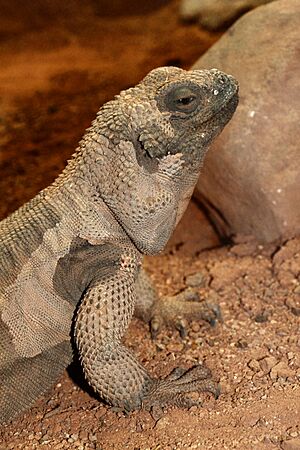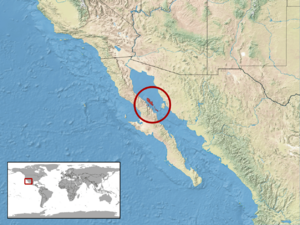Angel Island chuckwalla facts for kids
Quick facts for kids Angel Island chuckwalla |
|
|---|---|
 |
|
| Conservation status | |
| Scientific classification | |
| Genus: |
Sauromalus
|
| Species: |
hispidus
|
 |
|
The Angel Island chuckwalla (Sauromalus hispidus) is a large lizard. It is found only on Isla Ángel de la Guarda (Guardian Angel Island) and nearby islands. These islands are located in the Gulf of California. This lizard is also known as the spiny chuckwalla. Long ago, the Seri people moved these lizards to other islands. They did this to use them as a food source.
Contents
What's in a Name?
The scientific name for this lizard is Sauromalus hispidus. The first part, Sauromalus, comes from ancient Greek words. Sauros means "lizard" and omalus means "flat". The second part, hispidus, is a Latin word. It means "coarse" or "thorny". This refers to the spines found on the chuckwalla's tail.
The common name "chuckwalla" has an interesting origin. It comes from words used by Native American tribes. These include the Shoshone word tcaxxwal and the Cahuilla word caxwal.
Appearance and Size
The Angel Island chuckwalla is the second-largest type of chuckwalla. It can grow up to 44 centimeters (17 inches) long in its body. Its total length, including the tail, can reach 64 centimeters (25 inches). These lizards can weigh up to 1.4 kilograms (3.1 pounds).
They are considered a giant species of chuckwalla. They are two to three times bigger than chuckwallas found on the mainland. Young chuckwallas are dark brown with black bands across their bodies. As they get older, these bands fade. Their color then becomes a solid dark brown or black.
Where They Live
The Angel Island chuckwalla lives only on Isla Ángel de la Guarda. It also lives on 10 smaller islands in the Gulf of California.
Behavior and Daily Life
These lizards are harmless to humans. They are known to run away when they sense danger. If a chuckwalla feels threatened, it will inflate its body. It does this by filling its lungs with air. Then, it wedges itself tightly into a rock crack. This makes it very hard for predators to pull them out.
Male chuckwallas can be territorial, especially during certain seasons. If there is plenty of food, larger males often become leaders. They will dominate smaller males in their area. Chuckwallas use colors and body movements to communicate. They do "push-ups," bob their heads, and open their mouths wide. These actions help them defend their space.
Angel Island chuckwallas are active during the day. They are cold-blooded animals, meaning their body temperature depends on their surroundings. Because of this, they spend much of their mornings and winter days basking in the sun. This helps them warm up. These lizards are very good at living in the desert. They can stay active even when temperatures reach 39°C (102°F).
Family Life
Chuckwallas usually mate between April and July. The female lays five to 16 eggs. This happens between June and August. The baby chuckwallas hatch in late September. These lizards can live for a long time, often 25 years or even more.
What They Eat
Chuckwallas like to live in rocky areas and places with old lava flows. These spots have many nooks and crannies. These small spaces are perfect for hiding when they need to escape. Their homes usually have plants like creosote bush and cholla cacti.
Chuckwallas are mostly plant-eaters. These plants form the main part of their diet. They also eat leaves, fruits, and flowers from other plants. Sometimes, they might eat insects, but this is not their main food source.
Chuckwallas and People
The Seri people (also called Comca’ac) thought the Angel Island chuckwalla was an important food source. They even moved some of these lizards to other islands. They sometimes cross-bred them with San Esteban chuckwallas. This was done to make sure they had food during difficult times.
In the early 2000s, some reptile enthusiasts started breeding these chuckwallas. They wanted to create a San Esteban-like chuckwalla that people could legally keep as pets. The mixed chuckwallas are healthy and can have babies. They seem to have the best features of both types. They get the brighter colors of the San Esteban chuckwalla. They also have the calmer personality of the Angel Island chuckwalla.


